public art
Archived Posts from this Category
Archived Posts from this Category
Posted by justin on 29 Oct 2009 | Tagged as: acquisitions, adventure day, art paparazzi, possibilities, public art, renegade performances, rock!, silliness
StoneHenge in San Antonio? When I stopped to take the photograph, the homeowner came to the screen door and told me he was a carpenter. He said, “if anybody needed any work done, to tell them to stop on by.” The address is 327 Lone Star, San Antonio, TX 78204. Feel free to check it out for yourself.
Posted by ben on 22 Oct 2009 | Tagged as: art + bikes, arts organizations, celebrations, conceptual art, free food, graffiti, public art
This is a little reminder of some of the art events on this busy weekend.
Don’t miss any of this stuff! Seriously!
Posted by ben on 18 Aug 2009 | Tagged as: adventure day, art + bikes, arts organizations, performance art, public art, renegade performances

A Los Angeles Urban Ranger explaining something
The LA Times has a story up about the Los Angeles Urban Rangers, a group of “geographers, environmental and art historians, artists, curators, architects, and others” who dress up like park rangers and teach people how to enjoy public urban space responsibly. They lead urban safaris, such as a “guided hike of Hollywood Boulevard that deconstructed the famous street as if it were a natural park.” They teach people how to (legally) enjoy Malibu beach fronts where the homeowners have often (illegally) posted “Private Beach” signs.
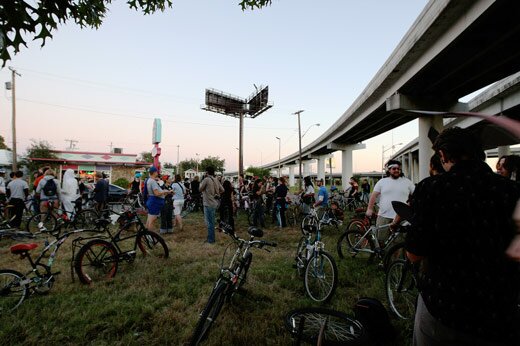
San Antonio's Bike Gang Summit, 2008 (photo: Justin Parr)
This is what performance art should be: seductively entertaining while challenging implicit assumptions about what constitutes public space and how it should be used. In their own way, the Final Friday bike rides (and Bike Gang Summits) in San Antonio encourage this kind of urban exploration, albeit with less explicitly pedagogical goals. Mark Jones and the rides’ other organizers lead bikers through obscure urban environments on the edges of downtown, descending on unlikely VFW halls and pocket parks. It’s a social sculpture if there ever was one.
Posted by ben on 21 Jul 2009 | Tagged as: architecture, ceramics, design, public art
Platform 21 is hyping repair as “the new recycling” with its Repair Manifesto, along with various contests and publicity efforts. It’s interesting that some of the “repairs” Platform 21 is publicizing are not functional or structural, but are really aesthetic in nature.
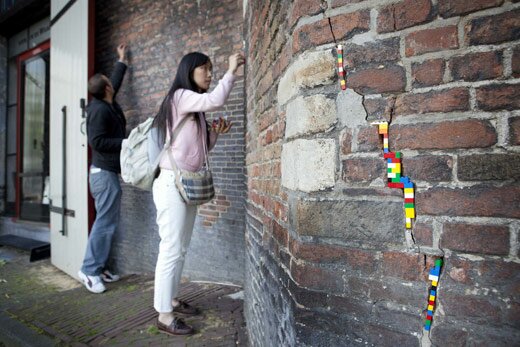
This Jan Vormann project is cool, but it doesn’t appear to offer much in the way of structural integrity. Then again, maybe that’s not the point — highlighting quirky projects like this means more attention for the project, and perhaps a broader reach for the “repair ideology” it is pushing. It also encourages people to think creatively about repair, and makes a chic movement out what often becomes just a greasy time sink. So here’s my contribution: a handmade porcelain teacup I broke and repaired a little while back. It’s not as flashy as Legos in a brick wall, or the “golden seams” of traditional Japanese tea bowl repair, but out of four similar cups, this is now my favorite.
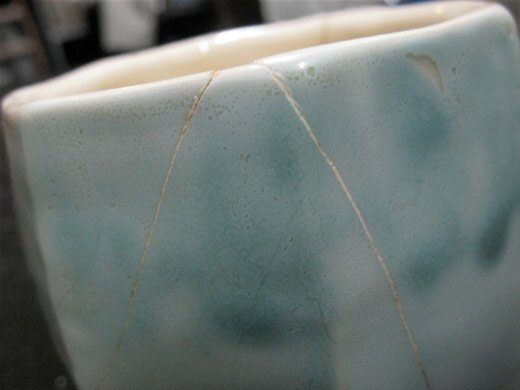
PS. This cup inspired another Emvergeoning post a while back.
Posted by ben on 26 Jun 2009 | Tagged as: graffiti, public art
I’m sure I’m late to the party on this one, but a friend just turned me onto French Belgian street artist Bonom (a play on bon homme?), who has worked in Paris and Brussels. Lots of good photos here.
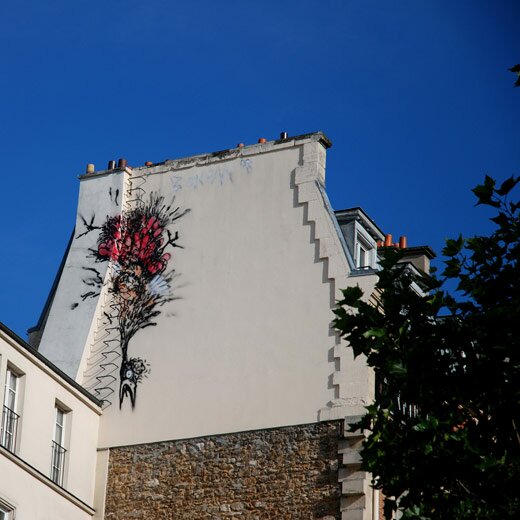
Posted by ben on 12 Jun 2009 | Tagged as: graffiti, public art, responses/reviews
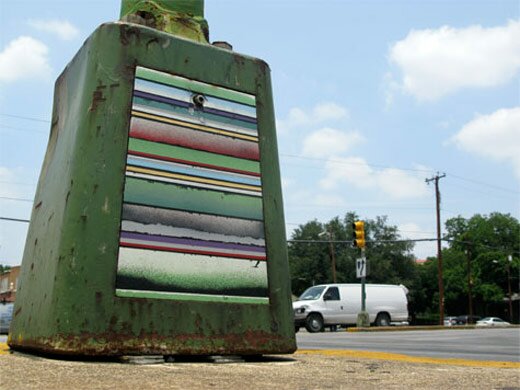
For my latest post on Glasstire, I took on a series by local artist and Emvergeoning contributor Aaron Forland. These pieces help us understand the differences between “street art” and “public art”:
Like a street artist, he uses spray paint on an existing surface, and doesn’t ask permission. But more like a public artist, he takes his time and carefully works over composition and placement (Forland removes these electrical covers, takes them home, methodically paints them, and then replaces them). Some of these pieces are months in the making. He also takes a painterly approach, and the series is much more reminiscent of a series of paintings than a group of tags.
I dealt with similar issues in a review for Art Lies a little while back (in this one I focussed more on street art vs gallery art, which would be an apt way to discuss Forland’s work as well). You can read it here.
Posted by justin on 22 May 2009 | Tagged as: art paparazzi, possibilities, public art
A little collection of photos from our upcoming river reach expansion project here in San Antonio. I was lucky to be able to go on the official tour with Ben a few weeks back and get a first-hand view of the unfinished project. There has already been a lot of local press covering the new reach and a blog dedicated to it exclusively on Mysa.com, so we had been notably lax in trying to get our images up online. We’ll start with the under bridge panel installation by Stuart Allen. Built of tightly woven metal strips painted in various colors, these panels slightly shimmer and change colors as the viewer walks past them, or floats underneath them by river barge.
Posted by ben on 20 Apr 2009 | Tagged as: architecture, arts organizations, celebrations, performance art, public art, r.i.p., video/film
When I was working on my first art review back in 2006, I saw a version of Edgar Arceneaux’s video “Old Man Hill” at the Artpace potluck that launched his residency there. The residency project (which later wound up in the Whitney Biennial) wasn’t as impressive as this simple homage to a man he never met: his father’s father. Arceneaux spelled out the only thing he ever knew about this man — that he was called “Old Man Hill” — in silver balloons, which hovered over the war-torn hills of Sarajevo. One by one the balloons released and twisted toward the sky. The cameras followed the balloons wistfully, clinging to these insubstantial forms seeking oblivion. Occasionally the cameras cut to people going about their lives in the city below, people looking away from these hills with their burned out buildings and piles of rubble.
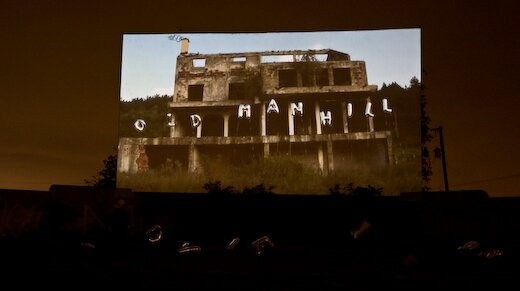
Linda Pace, who had not yet embarked on her battle with cancer, purchased this piece for her collection. Other than that potluck, the video had never been shown publicly; but before she died, Linda asked that it be screened at a special time, with the artist present. The Linda Pace Foundation arranged to screen the final version of this video for Linda’s birthday, last Thursday. Arceneaux was flown in to stage a performance along with the screening. The site selected for the project was the Mission Drive-In, a once-popular drive-in theater now dilapidated, graffiti-strewn, and slated for destruction. (It will be replaced with a new public library).
The evening of the event was overcast, windy, threatening rain. We got there early, and wandered around the old drive-in, its pavement giving way to grass, but its screens still fully intact. One by one, silver balloons were filled up and placed in front of the main screen, spelling out words that were unfamiliar to us, apparently a translation of “Old Man Hill” into Serbian Bosnian.
The translation of words hinted at another translation: the bombed-out hills of Sarajevo where snipers once found cover were translated into a theater in San Antonio, equally desolate, undergoing a wholly other kind of violence. This isn’t to equate the devestation of war to the disappearance of a drive-in, but to translate loss between cultures. Nearby the old theater, the Mission San Jose holds memories of a violence closer to that of Sarajevo: genocide, slavery, subjugation. But to most of us living in San Antonio today, the loss of place is felt more fully than the tragic, large-scale loss of life experienced by those who lived in Sarajevo in the 1990s or San Antonio in the 1700s. The slow erosion of the identities of our cities happens to be the kind of loss we are stuggling with now, the loss that we still don’t quite know how to grapple with.
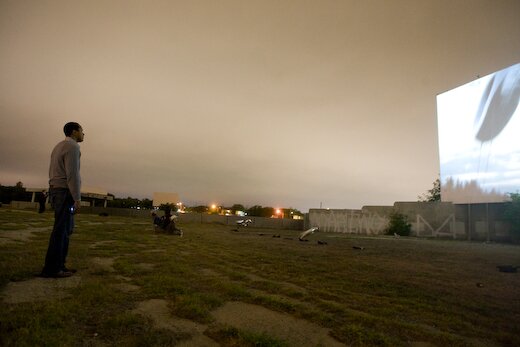
Eventually, as it grew dark, Arceneaux introduced the video, speaking of his search to learn something of his grandfather, a man neither he nor his father ever knew. This was a search to connect his identity to something larger, something more historically rooted. He spoke of his brief relationship with Linda Pace, who worked to create places in San Antonio that connect to what came before them: an old car dealership downtown becomes an artist residency space. This is the act of translating place — it doesn’t make sense to have car dealerships downtown anymore, but these spaces can be translated into something that is meaningful today, that turns loss and emptiness into another kind of value.
The video started, and as we watched Old Man Hill float away into the hills of Sarajevo, we also watched indecipherable words from another place float away into the San Antonio night, sometimes brushing slightly against the aging screen. And even as they disappeared from view, these words became embued with meaning. This was the final screening at the Mission Drive-In.
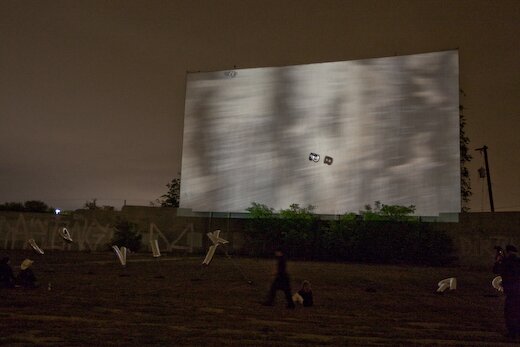
(Photos by Justin Parr, courtesy Linda Pace Foundation)
UPDATE: I’m honored to have Devin King respond to this in the second post on his new blog, Dancing Young Men From High Windows. Hopefully I’ll have time to respond to his post soon, but in the meantime I’ll point yall that way for an interesting reaction.
Posted by ben on 24 Mar 2009 | Tagged as: architecture, design, intellectual property, public art
UPDATE: I just talked to Bill FitzGibbons about an error and some clarifications that need to be made in this post. First off, FitzGibbons is being sued by the City of McAllen. FitzGibbons’ lawyers had drafted a letter to the city to discuss the apparent infringement of his rights, and the city responded by suing in federal court, requesting a ruling affirming their legal right to install this piece.
Apart from that glaring error, FitzGibbons pointed out compositional and conceptual similarities between the pieces. I have only seen two photos of the underpass in McAllen, so I’m just passing on FitzGibbons’ description. Compositionally, the McAllen piece is apparently very similar to Light Channels, in terms of the colors it uses and their sequencing. (In the Current article, McAllen officials are quoted as saying it is different because they did not employ the “chasing” effect that can be seen in Light Channels). Conceptually, Light Channels was designed to connect downtown San Antonio to the near east side, which is cut off by a highway. Highways create psychological barriers, the underpasses mostly being associated with vagrants, but Light Channels turns this into a safe, welcoming passageway. Similarly, , dividing downtown from the mall, the country club, the airport, and, just a little further south, from the border with Mexico. The underpass lighting in McAllen is at the intersection of 83 and S 10th St, a major street that leads the attractions listed above. FitzGibbons’ argument, then, is that conceptually as well as formally, this work mimicks Light Channels. Architectural lighting has been used on underpasses in a number cities; it is the form and purpose of the lighting that this case is dealing with, not the use of lights.
The original post is below:
The Current did some research into Bill FitzGibbons’ lawsuit against the city of McAllen, Texas for apparently ripping off his “Light Channels” piece in downtown San Antonio. From what I can tell, it’s pretty clear that McAllen’s new installation is at the very least extremely derivative of FitzGibbon’s work, and the city officials really ought to be ashamed for so blatantly ripping him off.
But at the same time, I’m not so sure about how successful this lawsuit will be. The lighting system FitzGibbons uses was developed by Philips, and is used for architectural lighting all over the world. If FitzGibbons can sue McAllen for sticking the lights in a highway underpass, whats to stop Fisher Marantz Stone (designers of the lighting on Brooklyn Borough Hall) from suing FitzGibbons himself for a similar use of Color Kinetics on the Alamo? This highlights the differences between designers’ and artists’ attitudes towards intellectual property. While a designer may regard a cheap imitation of her work with contempt, she’s generally not going to sue the offending party unless it’s an exact replica. Artists, I think, tend to feel a stronger sense of ownership over their work and even their concepts.
This may prove to be an interesting legal battle, as it seems it will be fought in something of a legal gray area. Of course, I’m not a copyright lawyer, and the case could be a lot more clear cut than I assume.
Posted by justin on 16 Mar 2009 | Tagged as: adventure day, art paparazzi, arts organizations, in yo face, party photos, performance art, possibilities, public art, rock!, silliness
Well, after a good deal of rain, some unexpected cold, and a little bit of worry, Luminaria 2009 turned out to be a really nice night in San Antonio. Aside from my experience with the overbearing police force (who wanted to tackle me for riding my bike down an empty LONG stretch of closed off road) I found this Luminaria to be much better organized and more satisfying to take part in. I carried my camera and photographed the projects I was able to come into personal contact with. Heres a selection of those photos, with my garbled commentary.
Laura Varela & Vaago Weiland collaborated on the Alamo this year. Vaago (from Mönchengladbach, Germany) said, in doing research on the Alamo, he kept coming across these photos with tents in the surrounding area. He was determined to surround the old Mission with 200 tents, however, upon closer inspection of the site was only able to squeeze in 54. Lauras video projection played alongside Vaagos sculpture, within the top of the Alamo.
Hyperbubble was the only real music I stood still and watched an entire set from. Not for lack of interesting options, but more in awe of the reaction of the crowd to their music. I heard more than several proclamations of “WHAT IS THIS?” and “THIS is the best band EVER!!” loudly from behind. I couldn’t have been happier.
My own piece (shamelessplug) was projected onto this old building(I was told it might have been called the Turner Magika Theatre?) facing out into the Hemisphere park, I showed the current version of my “Portrait of the Artist as a City,” a project I took up as a result of receiving a grant from the Artist Foundation. The video is made up of a constantly shifting set of over 9000 still photos, and encompasses more little parts of my life than I can begin to explain before losing your attention.
This year, the real showstopper for me was Ansen Seales 100 ft photograph of the San Antonio River. Contained inside the San Antonio Convention Center, It set the tone for the more conventional “walled,” section of the show. After talking to Ansen for a few minutes I was able to extract from him that this image was composed of 86,400 individual “slitscans,” made by his own homebuilt digital camera, and weighed in at a whopping 1.2 gigs for the file itself…and I thought trying to get my computer to juggle 9000 still photos at one time was tricky.
This fantastic ghost image of a dancer is local artist/instructor Rebecca Dietz. She was one of the roving performance artists, and a recent FL!GHT Gallery featured artist. I nearly missed her moving by me, and was glad I noticed who it was at the last minute.
John Mata, part of Leslie Raymonds New Media program at UTSA, built a cardboard room and filled it with books and media discussing…New Media.
Judith Cottrell & Gary Smith built this human like glowing form, and scared children for the duration of the night. I enjoyed watching.
Holly & Bryson Brooks decided it was best to be “Married with Paintings.” So they walked in at 6 on the dot, started working inside their makeshift studio(replete with audience the entire time), and by the time I rolled around with my camera, they were already at this point within each of their portraits of the other.
Back out on Alamo Street, Ethel Shipton had filled these two store front windows with her characteristic puffed objects, this time being birdhouses.
Kelly O’Connor was just a few windows down. My camera was having trouble not blowing out the detail in this one.
I stumbled upon this projection by Victor Pagona & his wife Sarah Susan, an artist I’ve heard of for years, but never met in San Antonio.
Sadly, I could only get this much of the smaller Leigh Anne Lester window displays without the detail of the sculptures being blown out by the harsh jewelry store lighting. These window displays will be available for all to see for the next month along Alamo Street.
I stumbled over this Michele Monseau projection right across the street from the Alamo, hidden on a side wall.
These patterns & lights can give you a general idea of what everything else looked like, that was not affected in some way by an individual artist or group of artists.
These two large scale Thomas Cummins Lightboxes, while difficult to do justice with a photograph, were mindblowingly detailed in person.
Another fine example of the general lighting scheme found that night. Its almost like that time I had to shoot photos at a certain laser light show..
Jenny Browne gave away 4 shopping cartloads and a truck bed full of books, for FREE, as her piece. It was awesome to see people swarming the truck and carts, trying to get at free books, while Jenny sat on the roof watching & laughing.
..and finally to end the weekend, Tom Otterness made an appearance with his newly unveiled(in our locale at least) public art piece, “Makin Hay’,” mentioned a few weeks back here at Emvergeoning. Some things I’m sorry to say I don’t have good photos of, the first being the EXCELLENT Contemporary Art Month installation by Randy Wallace in the basement of the old Beauty College building on Travis Street. I shot many photos of it, but none of them quite did it justice. I was also sad to miss crazy Mel Feldman and his cultural arts Kaleidoscope. Somehow 1000 artists all in one place on one night is just a LITTLE hard to keep track of.
Posted by justin on 02 Mar 2009 | Tagged as: adventure day, art paparazzi, opportunities, public art, rumors
After going through my old emails last night, Ed Saavedra and I realized that one of the press releases that had somehow slipped through the cracks was for a 2 year San Antonio exhibition by Tom Otterness (known to me because of his hard-to-miss 14th St Subway installation in NYC.) “Makin‘ Hay” is down on the Southside in one of my favorite empty fields next to the San Antonio River/Mission Trail, and near Mission San Juan. The release states that the piece will be unveiled on March 15, 2009. I called up a few folks this morning and heard that he had already been in town and that it was close to, if not fully, installed. Here are a few photos of what I saw when I got down there:
Posted by ben on 19 Feb 2009 | Tagged as: architecture, music, public art, sound art
Posting has been light this week because I’ve been helping Jason Kahn set up his sound installation downtown on E Travis St (which is officially opening this Saturday). Kahn, a Zürich-based artist, has been working with sound as a material for years, in both performance and installation contexts. The idea is to activate existing spaces in a way that reveals unnoticed qualities, architecturally, environmentally, and perhaps socially.
In some senses “San Antonio Beauty College” has a strong relationship to Max Neuhaus’ Times Square piece; it is unmarked, and mostly invisible (if you look closely you’ll spot some small speakers); it uses abstract textural sounds that change as you move around them; its significance in the environment is meant to shift as other sounds move along the street. But socially, it feels very different. Times Square could hardly be further from this little piece of Travis street in terms of the amount of foot traffic and the socio-economic makeup of that traffic.
The block of Travis where he is installing this piece (titled “San Antonio Beauty College”) is between Broadway and Alamo. Although it is near the Express-News building, and around the corner from the popular Twin Sisters café, we’ve noticed that no one who has a home seems to walk on this little stretch of Travis Street. The space has become a kind of social eddy, as the employed flow down Pecan or Houston Streets.
As I’ve been publicizing this installation, which is meant to be experienced from the sidewalk in front of the building, I wonder how the existence of the piece will impact the social space it inhabits. Will the people who ordinarily walk down this street notice the subtle sonic textures that Kahn has engineered to be concealed and revealed as the city sounds ebb and flow? Will it attract visitors from nearby businesses, or just the occasional art observer? I’ve often wondered if we’re too limited in the ways that we think about using public art: a monument here, a mural there. Have we overlooked the power of small, almost unnoticeable environmental responses to shift the social landscape? I don’t expect this installation to have much impact in that regard, but if you see me sitting in Twin Sisters watching the sidewalk all day, you’ll know what I’m doing.
By the way, check our event listings to the right for more information on Jason Kahn’s performance this Saturday.
Posted by ben on 11 Feb 2009 | Tagged as: outsider, public art, r.i.p.
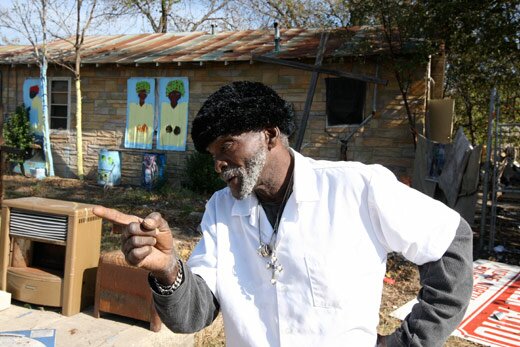
We have some very sad news to report: Rev Seymour Perkins, San Antonio’s outsider preacher-artist, has passed away. I’ve heard rumors he had cancer, but don’t have all the details. Emvergeoning wrote two long posts on Perkins, first as part of our San Antonio Outsiders series, and then a follow-up visit to document the work inside his home. I think the best place to see his work in person (since his house burned down) is the San Angel Folk Art Gallery.
[hat tip to ]
Posted by ben on 09 Feb 2009 | Tagged as: adventure day, public art, r.i.p., sound art
Last week I was surprised to learn of the passing of Max Neuhaus, and was a bit dismayed at the lack of coverage. The Houston Chronicle seemed to be the only paper covering the death of this important artist. But this morning I felt a bit better as the New York Times is out with their piece, and it’s a nice overview of his career.
Here, I thought I’d recount my first experience with a Neuhaus installation. I had been in New Hampshire to conduct the marriage of a good friend from college. On the way up, I learned of the death of my friend Alberto Mijangos, whose gallery I was running, and who in many senses had introduced me to art (I had attended his wedding in the Rothko Chapel at the age of five). Now I was headed back to San Antonio, a bit exhausted, trying not to think too much about this looming sadness.
My flight out of Manchester was delayed for hours. By the time it finally left, I had missed my connection in Newark, and the airline said it wasn’t their fault, so no hotel room. I decided not to pay for a hotel, to either sleep in the airport, or get in touch with a friend in the city. The one friend in New York I was able to reach was packing for a trip the next day, and didn’t have time for a visit. She helped me figure out how to get into Times Square, where I had heard there was a Max Neuhaus installation. By the time I made it into Times Square, it was about 11:30, still busy, but not too chaotic. I walked across the pedestrian islands until I heard a low ringing rumble flow up from the grates. As I stood there, transfixed in this invisible oasis, watching people and taxis wash over Broadway, I felt as if I was being enveloped by another world, which was really just an idea about perception. I rocked back and forth, listening as the sounds rippled and creased and rubbed, an infinitesimal percussion. Eventually, I made my way back the airport, and found a place on the floor to rest.
Posted by ben on 02 Feb 2009 | Tagged as: art paparazzi, graffiti, intellectual property, public art
Barry Hoggard posted a photo of a modified Aakash Nihalani piece in Williamsburg to his Flickr account yesterday:

When I saw this, I realized that street art is the original Creative Commons. Put something in a public space and it just begs for “collaboration,” resisting any claim to copyright. (Yes, I know that Creative Commons is not intended to do away with copyright but to make it more flexible, and that street art is more like a perpetual public domain).
Posted by ben on 30 Jan 2009 | Tagged as: graffiti, in yo face, public art
I thought I’d throw a little Friday-night fun your way: another Matthew Rodriguez piece spotted down the street from Emvergeoning headquarters. I think it goes quite well with the hand-painted signage on the Ruby Ann Cleaners.
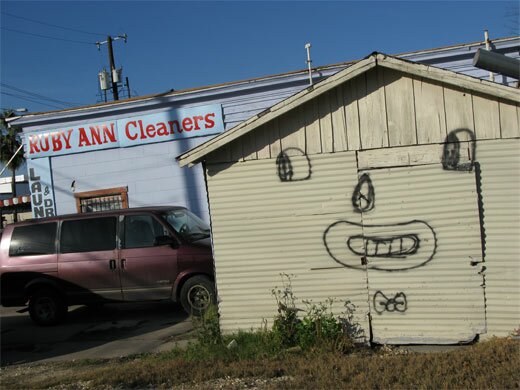
Posted by ben on 19 Jan 2009 | Tagged as: poetry, politics, public art
Jim Fisher, discussing the challenges Elizabeth Alexander faces in writing an occasional poem for the inauguration, explains why this kind of poetry doesn’t usually work:
Why is poetry so different from other disciplines? Music and the plastic arts (painting, sculpture, architecture) are demonstrably receptive to commissions, with great works created on command, as it were. With sculptures and buildings, we only have to walk a few downtown blocks in most major cities to see lasting examples of both, pro and con.
The problem for poets is not the commission — Milton’s “Lycidas” and Marvell’s “Upon Appleton House” are both immortal poetry commissions — but the occasion, which fixes the poem with a public event. Once the function has passed, the poem loses the immediacy of its audience, and with it the power to summon meaning and emotion over time.
So let’s dispense with this idea that poets can produce lasting poems for public events. It’s unfair to the audience, discomposes the poet, and probably confirms the low opinion of poetry some listeners already hold.
When we read poetry to ourselves, the occasion of a great poem is an internal event, organizing the perceptions and determining the material. When that occasion is a point in time and place, the work is more likely to be stuck there when published: partial, responsible, contemporary, rarely timeless.
[hat tip]
Posted by thomas-cummins on 18 Jan 2009 | Tagged as: interviews, politics, public art
Inauguration weekend is underway. Kurt Andersen investigates ‘Artists and Obama‘ at Studio360.org. You can find the following interviews there for your listening pleasure:
Shepard Fairey, designer of the iconic red-white-and-blue Barack, and other Obama portraitists admit to riding the Obama wave but fear they might have over-hyped the president-elect to unrealistic expectations.
The departing chairman of the National Endowment for the Arts, Dana Gioia, was a Bush appointee but he’s down with a Democrat who reads poetry.
Sculptor Richard Serra asks Obama for a Culture Minister as well as for a grassroots art movement.

Posted by aaron on 14 Jan 2009 | Tagged as: arts organizations, essays, in yo face, music, mustaches, possibilities, public art, r.i.p., rock!, wordy
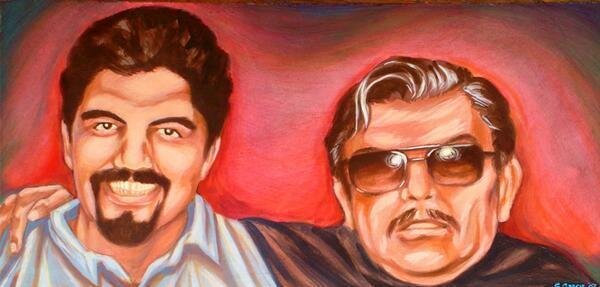
Manuel Diosdado Castillo, Jr. tragically succumbed to lung cancer on January 6th at the age of 40 – a matter of weeks after receiving the diagnosis – leaving behind a remarkable legacy of music, public artwork, of pride in and a powerful sense of responsibility for his beloved Westside San Antonio barrio. Manny was, for nearly twenty years, a singular presence in both the underground music scene in San Antonio (whose spiritual epicenter is marked by the centuries-old live oak tree at his favorite local dive/venue: the legendary, much-missed Tacoland) and in the non-profit community organization he built, originally as an offshoot project of Patti & Rod Radle’s Inner City Development, but which quickly blossomed into San Anto Cultural Arts.
My friendship with Manny goes back to a spontaneous garage rehearsal circa 1991. Marshall Gause and I were fruitlessly waiting at my folks’ house for some now forgotten drummer we wanted to try out, as our last band line-up hadn’t worked out. Marshall suggested trying to get in touch with this guy he had played a couple of times with the year before – they had enjoyed it, but it didn’t go anywhere as Manny soon left for New Orleans to follow Academic Pursuits. Marshall had a hunch he might be back in town now. After a few calls, the hunch was confirmed and we had a drummer on the way.
That first rehearsal (guitar, bass, & drums – singer Terry Brown had to work) immediately revealed an undeniable chemistry between Marshall’s hippy-punk musicologist guitar explorations, my intuitive but rudimentary bass playing (which, lucky for me, sounded better than it had much right to thanks to my chronic music obsession, a plethora of interesting audio exposure at a job selling used records, and especially Marshall’s unpretentious ability to cover for my lack of formal musical knowledge,) and Manny’s balls-out, hit-the-drums-hard-enough-to-break-at-least-one-head-per-session-but-always-dead-on-the-beat style, using complex rhythms even formally trained jazz drummers wouldn’t have the nerve to try. He was, and remains, one of the fastest, most precise drummers I have ever seen (even faster when he was nervous,) augmented by the physical strength to just bash the hell out of his drums – a steamroller cross between John Bonham, Neil Peart, Mitch Mitchell, George Hurley and Elvin Jones. All on a minimal and creaky drum set usually somehow held together with yarn.
That afternoon we quickly bonded musically over our mutual love for Rush, The Plugz, Esteban Jordan, Thin Lizzy and especially The Minutemen. Spontaneous jams we engaged in that day became the basis for numerous songs later fully developed and forming the initial base of our oeuvre (some still included in the set list at the time the band imploded.) In short order, we brought Terry back into the circle, sat around with some Lone Stars or whatever was cheap that day and soon agreed to call ourself El Santo, in homage to the legendary Mexican lucha enmascarada/film star who never lost a match.
Posted by ben on 13 Jan 2009 | Tagged as: art paparazzi, music, party photos, public art, r.i.p.
A few photos of Manny Castillo’s casket being painted by his friends and colleagues in the local art community:

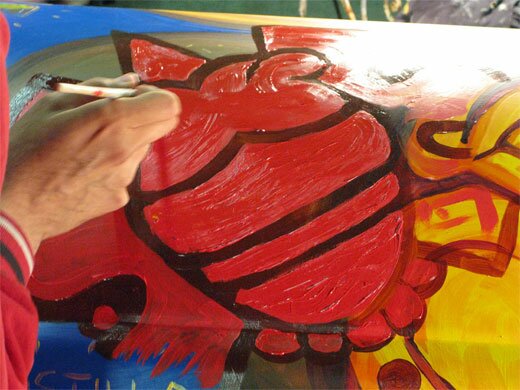

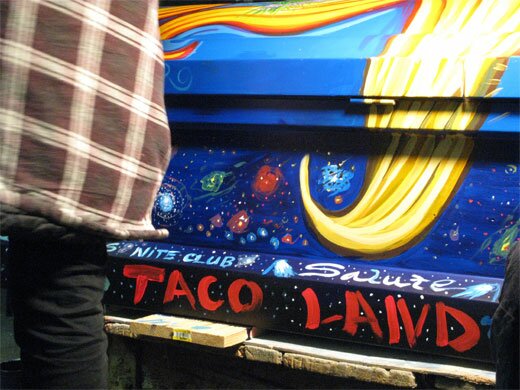

See also: San Antonio Express-News blog post with a number of murals facilitated by Castillo’s San Anto Cultural Arts; the Express-News obit; the San Antonio Current’s just before his death.
Posted by ben on 27 Nov 2008 | Tagged as: acquisitions, art paparazzi, design, public art, sneak peeks
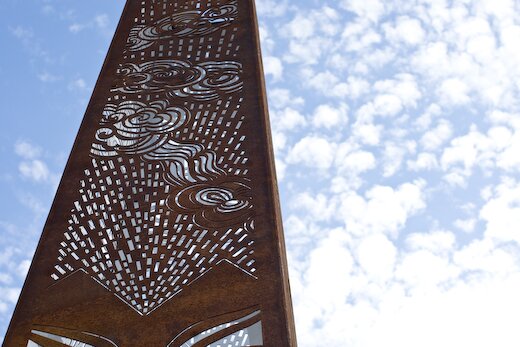
San Antonio’s newest public artwork was installed yesterday at the intersection of Blanco and Fulton, in the center of a new roundabout. The internal lighting system is not installed, however, and the piece will not be completed until a December 15 lighting ceremony. A press release sent out by Public Art San Antonio explains the significance of the piece:
The design of this new public art work at the roundabout draws a physical and spiritual link between “Beacon Hill”, the name of the neighborhood in which it is located, and its two most predominant architectural styles: Art Deco and Arts and Crafts. These are symbolically represented by the artwork’s two main components: a “sunburst” motif on the brick pavement of the roundabout and its obelisk-shaped “beacon/luminaria.” The “sunburst”, the most popular of all Art Deco motifs, metaphorically stands for its life giving force and the revitalization of the inner city business corridor. The “obelisk”, a symbolic quadrangular vertical sunray made out of steel, will serve as a sundial during the day. Its perforated allover design begins at the bottom with symbols of indigenous ancestral life cycles followed by references to the landscape that the traveler encounters on route to the town of Blanco, Texas.
Emvergeoning made it out to snap a few photos, followed by (highly recommended) pumpkin empanadas from the D.J. Bakery down the street.
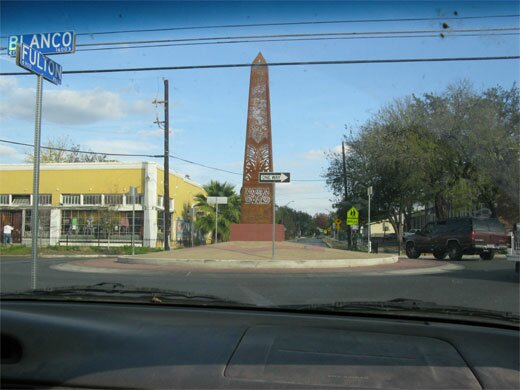
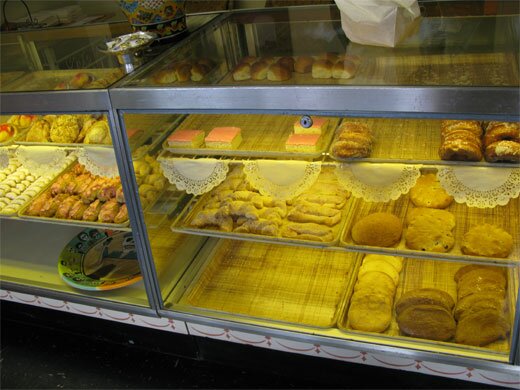
Posted by ben on 15 Sep 2008 | Tagged as: architecture, design, graffiti, public art, responses/reviews
Near the end of the Q&A following the Art Guys‘ lecture at UTSA last week, one woman challenged the Houston collaborative’s assertion that their art doesn’t have to mean anything. For this audience member, meaning arises between the object and the viewer, regardless of the intentions of the artist. She must have touched a bit of a nerve; for the first time all night, the Art Guys set aside their jokey, unpretentious demeanor and turned ever-so-slightly preachy. Although the exchange was grating to my ears, it revealed quite clearly an underlying agenda of this 25-years-in-the-making art duo: to short-circuit meaning and expectations in human interaction. At one point, Art Guy Michael Galbreth pointed to a chair and rhetorically asked: What does this mean?
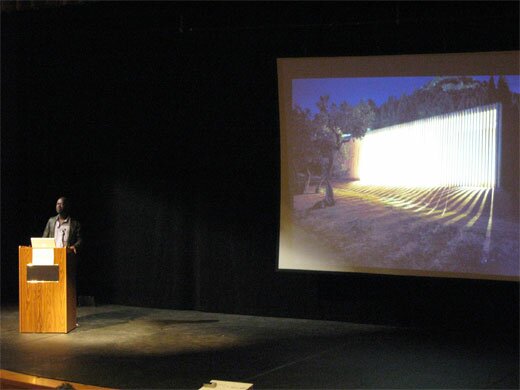
The following night, UTSA (in collaboration with Artpace) hosted a lecture by David Adjaye in which he focussed on his work with public spaces. Early in the lecture he raised the idea of “editing the city.” Throughout the talk this phrase came back to me again and again, as I saw Adjaye weave together cultural artifacts, contemporary urbanist theory, and old-fashioned human proportions into buildings that are at once blank and full of personality. What became clear is that a building can be a segue in an urban environment between two types of space (or even two senses of time), it can tell you something about the city, or about how you should interact. In one case, Adjaye insisted on building a café on the top of a larger London building he was designing, while his clients and others wanted it on the street level. During the lecture he pointed out that having this café above the street would allow people who spend all day on the streets to have a view of the city from above — to see the skyline and the rooftops. But beyond the aesthetics, this placement says something about leisure time, and the way that people ought to share it. Above the street. Away from the hustle.
And so this building says something about the way that people ought to interact, about what they should value. In this same sense, a chair says something about how and where we ought to sit. In the auditorum where the Art Guys spoke, all of our chairs were lined up in a particular way that focussed our attention. If we had walked into a room with 500 pillows on the floor, the space would indeed have had a different meaning. So yeah, Mike, the chair means something.

But I don’t intend to play a game of gotcha here. John Cage was perfectly right to say that ““, and the Art Guys do a fine job of short-circuiting meaning in a way that reveals and deepens acts of observing and understanding. An example: During a residency in San Francisco, the Art Guys noticed a dumpster across the street from their apartment. They watched as the community used this resource as a place to discard, and a place to acquire. Something to crouch behind while shooting up heroin, something to throw up in. A canvas for the taggers. It was constantly overflowing with trash, pushed from one end of the parking lot to the other, covered with grafitti. One evening the Art Guys painted the dumpster gold. Shortly thereafter, the property owner cleaned up the area, and started keeping the dumpster under lock and key. The question of why all this happened — why the dumpster was painted gold, why it was treated differently after being painted — is a kind of absurdity that reveals a lot about human interaction. In a sense, it doesn’t mean anything. But it is a catalyst for observation and thought.
Where David Adjaye revealed something about a city by imbuing a building with a different kind of meaning, the Art Guys revealed something about a city through an act of absurdity. In architecture, so often forgotten among its inhabitants, Adjaye pushes us to awareness with an overriding sense of intentionality and purpose; in art, so often overanalyzed by its devotees, the Art Guys push us to awareness with unrelenting whimsy.
Note: The Art Guys have an exhibit called Cloud Cuckoo Land up at UTSA’s 1604 campus through October 12. David Adjaye’s exhibit, Making Public Buildings, is up at Artpace through January 4.
Posted by michelle on 20 Aug 2008 | Tagged as: public art
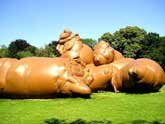

Thanks to the writers over at BBC, I enjoyed a good laugh this week. Apparently, Paul McCarthy made some gigantic, inflatable turds in Switzerland and one of them got away. Paul Klee meets “Complex Shit.”
Posted by justin on 15 Aug 2008 | Tagged as: acquisitions, adventure day, art paparazzi, performance art, public art, silliness
In between running around shooting photos of record stores and weird museums today, I managed to make it by the Alamo and catch Jacob Goudreault (fresh in town from Chicago, IL) doing a performance / painting give-away in front of our favorite old mission.
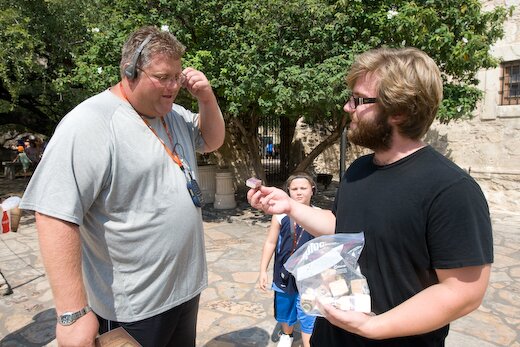
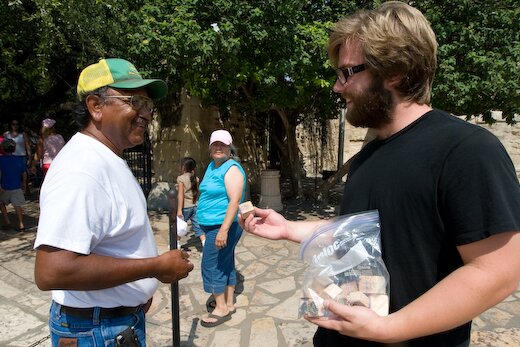

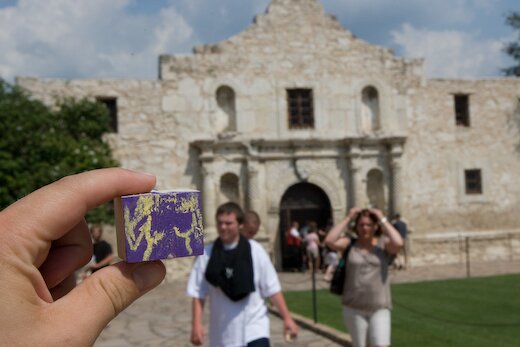
Posted by ben on 13 Aug 2008 | Tagged as: politics, public art, responses/reviews, video/film

There’s been some grumbling lately about the “fake fireworks” at the Olympics in Beijing. Here’s how the story goes: the people responsible for planning the fireworks developed a display that would outline 29 footprints in fireworks from Tiananmen Square to the Bird’s Nest stadium. Due to the grandiose nature of this display, no single person would be able to see it all — not even from a helicopter. So the special effects team spent a year developing a CGI version of the footprints, made to look as if a helicopter were flying along the route filming it live (including a shaky camera and digitally generated Beijing smog). This video was inserted into the “live” broadcast stream sent to TV networks worldwide, and shown within the stadium itself. No disclaimer was ammended to the video, so audiences thought they were watching “actual” fireworks. When the truth was revealed, many viewers became upset at the deception.
There are so many implications to this I don’t think I can really unpack it all here, but I’ll give it a try. To begin with, we have the notion of authenticity. This July article from the New York Times helps explain the the gap between Chinese and Western relationships with authenticity. (Most of the relevant discussion comes on the last page of the article, e.g.: “it is common practice [to] substitute copies of famous works of art in museums when the originals are unavailable.”) The fireworks actually happened, but to give an impression of the true scope of the display, some cinematic sleight-of-hand was necessary. Here’s a video someone shot of the — not so impressive. The idea here was not to embellish reality, but to give viewers some sense of a reality they couldn’t fully experience. A disclaimer would in some sense rob viewers of the experience as well: perhaps ironically, the closest a viewer could get to experiencing the full display was to watch a CGI version of it thinking it was authentic. But, for a Westerner, that won’t do. If our experience of a thing must be partial in order for it to be real, so be it, even if that “reality” is only through the TV screen. We’d rather watch a video of part of the display, and then read about how it stretched across Beijing, than to see a simulation of the whole thing.
I’m sure it would be possible to go on for a few thousand more words on the ideas of authenticity that this brings to the fore (sprinkling in some appropriate snippets of Baudrillard, of course), but let’s move on. What was the point of this display? In the West, Tiananmen Square is largely associated with the Tiananmen Square Massacre, but its history is a comprised of a long string of political and military conflicts. Symbolically, it can be seen as the seat of political power in China, stretching back to the Ming Dynasty. These footprints, walking from the site of battles, protests, massacres, and Mao Zedong’s proclamation of the People’s Republic of China in 1949, to the site of the Olympics, represent China’s lurching entry into the capitalist global economy.
China is stuck in a precarious position with the West: it constantly signals that it wants to engage as political equal with the US and the EU, but cannot bring itself to uphold even the inconsistently enforced standards of human rights cherished by the West. As noted in the Sky News article linked above, the architect who designed the Bird’s Nest stadium recently wrote on his blog about the Beijing Olympics:
He was directly critical of China’s ruling communist party, characterising the ceremony as “a showcase of the reincarnation of the Marxist imperialism; the ultimate paragon of an all embracing culture of fascist totalitarianism; an encyclopaedia that encompasses total defeat in intellectual spirit.”
Perhaps the Chinese relationship with authenticity is indicative of a deeper disconnect between the Chinese and Western understanding of the world. Even in its symbolization of a movement towards Western values, China has managed to offend.
UPDATE: Oh yeah, and then there’s this.